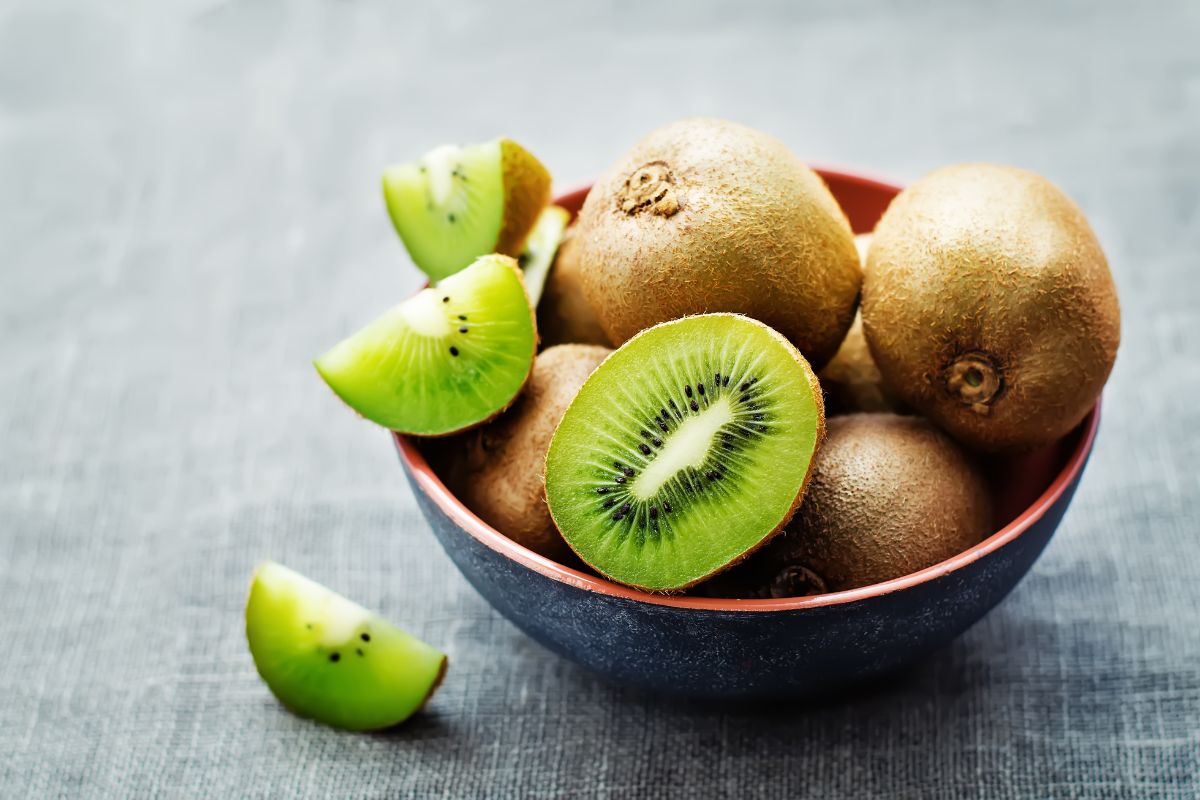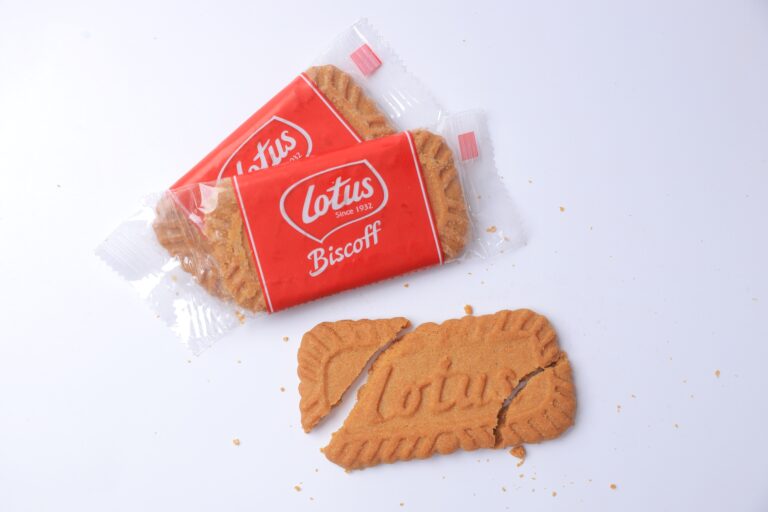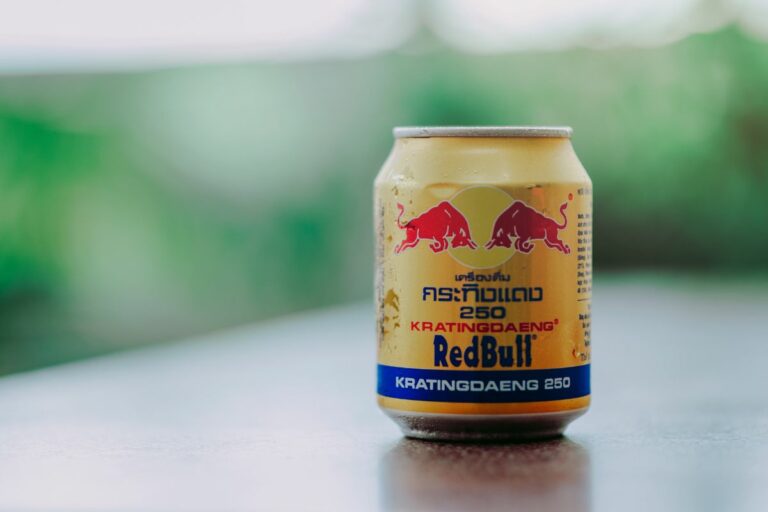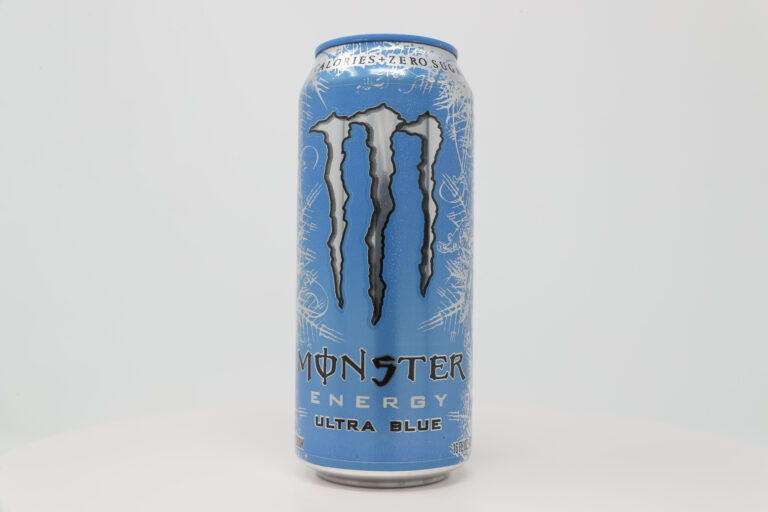What Does Kiwi Taste Like?
Filled with nutrients and health benefits, Kiwi has been a frontrunner for its supposed good taste. But, Most of the healthy foods like kombucha and etc taste bad. You may doubt the ‘tasty claims’ and ask, what does kiwi taste like? Is it good?
The flavor of the kiwi fruit is distinct, best described as tangy or tart. It also has subtle hints of acidity to it. Some describe the taste of kiwi as a combination of strawberry, citrus, banana, and pineapple. The fruit has certain berry-like qualities such as tartness, citrusy, and juice. Unripe kiwi fruits tend to be more acidic compared to ripe ones which are sweeter.
In this article, we have compiled a full guide about kiwi and how to use them. We have talked about the different taste profile of different varieties of kiwi and the health benefits associated with them.
Without further ado, let’s get started.
What Does Kiwi Taste Like?

The kiwi fruit has a unique flavor that can be best described as tangy or tart with a hint of acidity. Unripe kiwis are more acidic, whereas ripe kiwis are sweeter.
If we talk about looks, kiwi doesn’t look that appealing. While Kiwi is a berry, it lacks the visual appeal and the natural gleam of other berries. Berries like strawberry and blueberry have a natural beauty ascribed to them.
Kiwi is different. It has a sort of ‘Fuzzy appearance’ with fur attached to its skin. The fruit can sometimes be confused with a rolled-up animal.
However, the taste makes the mouth talk. The kiwi has a unique flavor that might confuse someone who only judges it by how the fruit appears. The fruit is slightly acidic like other fruits belonging to the berry family.
It has a rich tartiness that ends with a subtle hint of tanginess. Its flavor profile can be best described as a combination of strawberry, pineapple, citrus, and banana. The acidic flavor is prominent when the fruit is unripe.
While unripe kiwi fruit has an acidic profile, ripe kiwi has quite the sweetness attached to it. Ripe kiwis tend to have a more sophisticated taste. It has a rich sweetness that is accompanied by a sweet fragrance. The fruit is also less acidic and has that natural tanginess that all berries possess.
Kiwis also have a distinct aftertaste. The fruit leaves tingling or numbing sensations in the mouth which some people equate with soda water or seltzer.
This ‘fizzy’ aftertaste is caused by a special enzyme named actinidain. This enzyme dissolves proteins and is commonly found in papayas, kiwis, and pineapples. The aftertaste usually goes away after a few minutes and is not harmful.
While Raw kiwis have this taste profile, cooked kiwis are a whole other thing. The taste of cooked kiwi fruits depends on the dish and how it is being used.
Different Tastes and Flavours of Different Kiwis
Kiwi, like any other fruit, have a lot of varieties that have different tastes and different characteristics.
Green Kiwi
The Green kiwi is the most popular kiwi because it can be found all year round. The skin of the kiwi has a brown color and has a lot of small hair on it. The kiwi flesh is bright green and has multiple black seeds in the middle of the pulp.
This kiwi has a mild sweet taste with an added side of sourness. It is packed with fibers but has low amounts of Vitamin C compared to the other kinds.
Rossana Italian Kiwi
This particular variety of kiwi originated in Italy. It has a larger size compared to your average kiwi. It grows seasonally and has light green colored skin. It also has a sweet fruity taste to it.
Red Kiwis
Unlike green kiwis, red kiwis are hard to find. They have dark brown skin with a greenish tint and are completely hairless. The flesh has a beautiful red color with black seeds.
The taste can be described as exceptionally sweet with a certain berry-like hint to it.
Golden Kiwi
Golden Kiwi has a rich golden color to it with a completely hairless appearance. Its flesh is golden and has fewer seeds. You can just pick it up and eat it without peeling the skin.
The golden kiwi has a deep sweet taste due to its high fructose content. It also has a more soft and mushy texture than your normal green kiwi. It also has more Vitamin C than other kiwi fruits but has less fiber.
Hardy Kiwi
Hardy kiwi is often grown in the colder seasons. This kiwi has many different varieties. It also has small in size, so you can eat it without peeling it.
When it’s ripe, it has a pleasantly sweet, and juicy taste. Some even think it is the tastiest variety of kiwi fruit.
Dumbarton Oaks Kiwi
This is the most unique-looking kiwi. It has no signature kiwi-like fur on it. Its skin has a ribbed pattern like a pumpkin. It’s also smooth and completely hairless. So, you can eat it without the skin.
The kiwi is sweeter than other kiwis. It also has a rich aroma that will increase your appetite.
How To Tell If a Kiwi Is Ripe
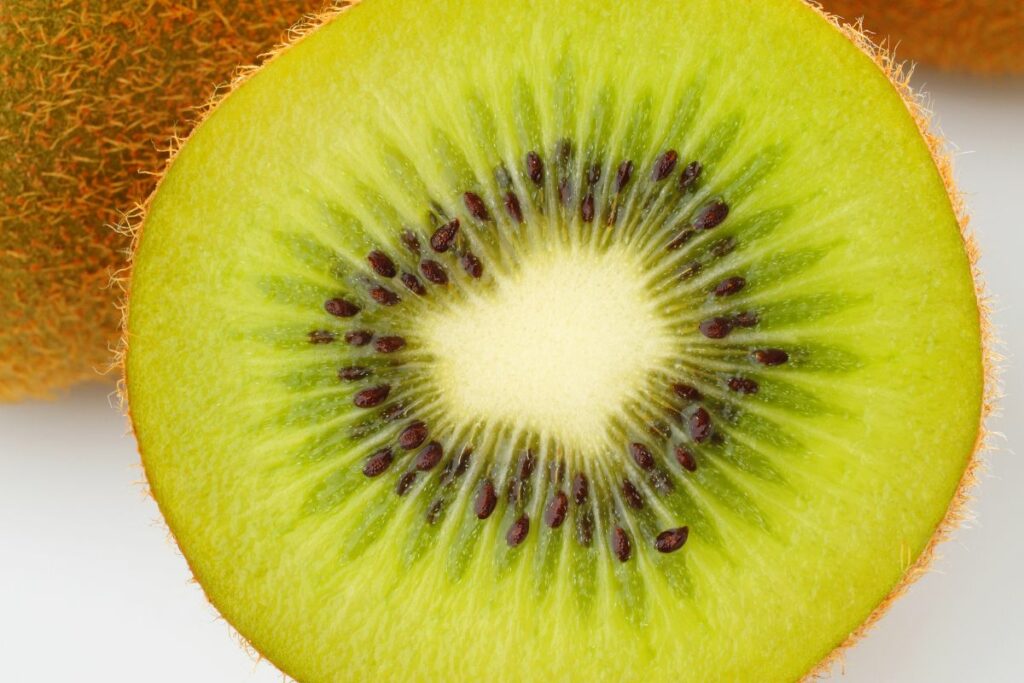
The taste of the kiwi is greatly dependent on its ripeness. Ripe kiwis have the delicious sweet taste that all love. But, telling if a kiwi is ripe is not that easy. To make sure that a kiwi is ripe, you have to look for some signs.
- A ripe kiwi will always a brown skin covered with fuzz on the surface. If you can see that the fruit’s outer layer has green patches, then it is not ripe.
- A ripe kiwi has a plump and bulbous shape with a round body. If the surface looks firm instead of plump, then the fruit is not ripe yet.
- Take a kiwi and put your nose on the spot where the kiwi was attached to the vine. If the smell coming from there is sweet and fruity, then your kiwi is ripe. Unripe kiwis don’t have any smells to them.
- Take a kiwi in your palm and gently apply pressure on the fruit. If the flesh gives slightly, then your kiwi is ripe. If it feels too hard, then it’s unripe and if it feels mushy, then it’s overripe.
How To Tell If a Kiwi Has Gone Bad
Like any other fresh produce, kiwis can go bad after a certain time. You cannot just buy a bunch of them and leave them for an unidentified time period. You have to make sure you eat them while they are fresh or else, you might face some problems.
Check For Molds
Take the kiwi and look at it closely for brown or green mold. The mold might appear fuzzy with flecky white spots on the surface and the pulp. If any part of the kiwi has molds on them, then throw the whole food away.
Dry Skin or Pulp
If the skin or the pulp looks dry, then your kiwi has gone bad. Kiwi pulp is filled with juice and should feel wet at the touch. If your pulp appears dull and dry or white, then it means your kiwi has gone bad and should be discarded.
Mushy Patches
If you see or feel any wet or mushy patches on your kiwi’s skin. Then it is a sign that your kiwi is spoiled.
Acidic smell
Kiwis tend to have a citrusy and light smell, with a tad bit of sweetness. If your kiwi has a slightly off-putting smell or acidic smell, then it’s a sign of spoilage.
Mushy or Hard Feel
A sure way to tell about the freshness of a kiwi is by hand. Take the fruit in your palm and squeeze it gently. Don’t apply too much pressure. If the fruit appears hard, then it needs time to ripen. If it feels mushy, then it has gone bad.
The Nutritional Value of a Kiwi
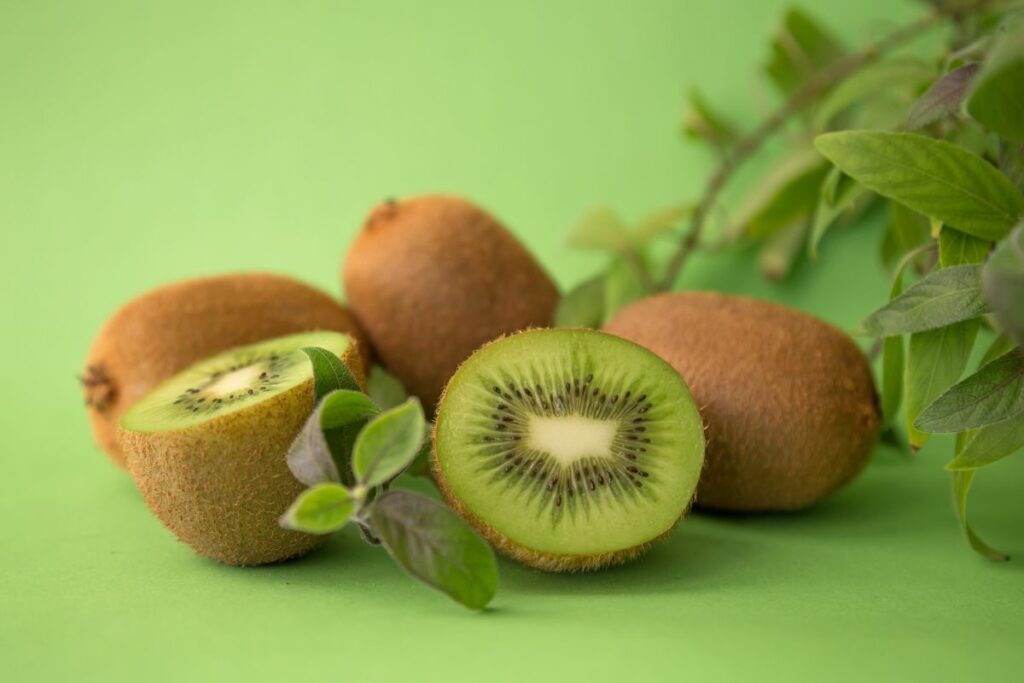
Kiwi has brought a new wave of health-frenzy into the mass crowd. People swear by its health benefits and the popularity of the fruit is just rising. Nutritionists also deem kiwi as a nutrient-dense ‘super food’. So, Let’s take a look at the nutrients present in this ‘super food’
| Nutrient | Amount in 1 kiwi (69g) | Daily Adult Requirement |
| Calories | 42.1 | 1600-3000 |
| Fiber (g) | 2.1 | 22.4-33.6 |
| Vitamin E (mg) | 1.0 | 15 |
| Calcium (mg) | 23.5 | 1000-1300 |
| Carbodydarates (g) | 10.1 | 130 |
| Sugar (g) | 6.2 | 36 |
| Vitamin K (mcg) | 27.8 | 75-120 |
| Copper (mg) | 90 | 890-900 |
| Vitamin C (mg) | 64 | 65-90 |
| Beta Carotene (mcg) | 35.9 | No data |
| Potassium (mg) | 215 | 4700 |
| Magnesium (mg) | 11.7 | 310-420 |
| Lutein & zeaxanthin (mcg) | 84.2 | No data |
| Folate (mg) | 17.2 | 400 |
| Phosphorous (mg) | 23.5 | 700-1250 |
From the table, we can clearly see that the mass conception about kiwi is not wrong. It is actually super healthy food that is packed with nutrients.
Is Kiwi Healthy?
Of course, it is. The health benefits of kiwi have been the main driving reason behind the ‘kiwi frenzy’. People are left dumbfounded after they get to know about the marvelous health benefits of consuming kiwi.
Prevents Blood Clotting
Kiwi and reduces the amount of fat in blood levels. This helps to prevent blood clotting and high blood pressure. Kiwi does this without negatively affecting the good cholesterol in your system.
Doctors usually prescribe aspirin for patients who are at risk of cardiovascular disease. Studies have shown that daily consumption of 2-3 kiwis can prevent cardiovascular diseases more effectively than aspirin.
Helps With Asthma and Improves Lung Health
People who suffer from asthma can appreciate a pair of healthy lungs. The constant wheezing and breathlessness is a major problem that interrupts day-to-day activity.
Fortunately, Kiwis can reverse that. Being rich in Vitamin C and antioxidants, kiwis can control the symptoms of asthma and improve your overall lung health.
Improves Digestion
Kiwi contains a huge number of dietary fiber which helps with digestion. The fiber, combined with the water in this fruit, gives your gut some relief while improving your metabolism.
Also, kiwi has an enzyme named actinic in it. This enzyme breaks down proteins which can aid your digestion after a heavy meal and reduce bloating.
Improves Eyesight
Kiwi stops macular degeneration and vision loss. It contains zeaxanthin and lutein or the ‘eye vitamins. These compounds perform the same task as antioxidants and help to form vitamin a in your body.
The compounds also absorb excess light to protect our retinas and protect the eye from other ocular diseases.
Reduces DNA Damage
The imbalance between free radicals and antioxidants in your body is called oxidative stress. This causes a strand breakage of DNA which leads to hard-to-detect diseases.
Antioxidants in kiwi help to lessen this oxidative stress. In a study where participants’ cells were damaged with peroxide, those who took kiwi supplements had better DNA repair capabilities after the peroxide treatment.
Ensures Healthy Skin
The vitamin c present in kiwi helps to synthesize the collagen in your body. Collagen supports the structure of your skin and bones. Kiwis can support the structure of your skin and keep it hydrated and healthy.
Also, vitamin c has anti-inflammatory properties and can help people suffering from skin issues.
Promotes Weight Loss
Kiwis have a high number of dietary fiber, water, and vitamin c. This enables kiwi to be an awesome weight-loss food. Eating kiwi will make you feel full for a long time.
Kiwi is also low-calorie and has a low-glycemic index. This means that the sugar in the fruit will be released over a long period which is very helpful for your blood sugar levels.
What’s The Best Way to Eat Kiwi?
Kiwi is a versatile fruit that can be enjoyed in multiple ways. While you can eat it raw like any other fruit, you can also cook it and elevate your dish with its natural tanginess.
Kiwi has a natural tenderizer in it which is why it is used in the preparation of red meats. Also, you can make a smoothie or juice out of it like any other fruit.
Raw
The easiest and the most widespread of eating kiwi is eating them raw. Take a kiwi and wash it thoroughly. Slice it up into bite-sized pieces. You can also cut it in half and scoop out the flesh with a spoon.
Smoothies
Like any other fruit, you can make a smoothie out of kiwi. The drink contains all the nutrients and tastes very good.
To make a kiwi smoothie,
- Mix banana slices, kiwi, and any other fruit in a blender.
- Add ice and yogurt to it. You can also add skim milk instead of yogurt.
- Mix all the ingredients and add sugar for added taste.
Behold! You have your very own homemade healthy smoothie that will energize you in the summer.
Parfait
Parfaits are known for their fruity and sweet taste with a rich creaminess. Fortunately, You can easily make kiwi parfaits in your home without any fancy ingredients.
- Take a glass. Peel and slice your kiwi and make sure to get rid of any skin.
- Layer low-fat yogurt, the kiwi pieces, and low-fat granola in the glass.
- Top the mixture with a layer of honey and nuts for an extra sweet kick.
Jam
You can easily make a healthy and nutritious jam out of kiwi fruits in your home! All you need is some chopped or sliced kiwi fruits, pineapple juice, apples, lemon juice, and sugar.
Mix all the ingredients in a blender and blend until the mixture reaches the jam consistency. Eat the jam with any type of bread you prefer.
Salsa
Let’s talk about something spicy for an instant. Kiwis make an incredible salsa that has a zesty and tangy taste to it. Take some mango, kiwi, and cilantro.
Chop them up into bite-sized pieces. Mix them with a dash of lime juice and honey. Mix the ingredients thoroughly and you have your healthy, homemade salsa that can be enjoyed as a side dish.
Kiwi Cobbler
Kiwi cobbler is an easy and tasty dish that you can make at your home! This light yet filling dish can easily resolve that pesky afternoon or night-time hunger.
Take a kiwi and slice it up. Mix brown sugar, flour, nutmeg, lemon, and grain muffin mix. Mix it thoroughly and you have your kiwi cobbler. Serve it warm with ice cream or frozen yogurt. You can also add some syrup to it to enhance the taste.
Final Words
Now when someone asks you questions about kiwi such as what does kiwi taste like, whether can you eat kiwi skin or the health benefits of kiwi, You can dazzle them with these facts.
The kiwi fruit has a distinct flavor that can best be described as tangy or tart. It also has a slight acidity to it. Kiwi is said to taste like a combination of strawberry, citrus, banana, and pineapple. The fruit has berry-like characteristics such as tartness, citrusy flavor, and juicy texture. Unripe kiwi fruits are more acidic than ripe ones, which are sweeter.
We hope that you have found the answers you were seeking and can use this article in your day-to-day life. Now, get a kiwi and start cutting it.

